In this section you will find information about the “mainstream” practice of Chiropractic throughout the world. You will find information from two perspectives:
A. Descriptive analysis of chiropractors and the chiropractic profession;
B. Descriptive analysis of chiropractic patients and their utilisation of chiropractic.
Given that Chiropractic is a relatively young profession, some parts of the world are well-researched (e.g USA) and other areas are scarcely documented (e.g Asia). Defining mainstream practice has often been a challenge with Keating [1] noting that there is considerable diversity in beliefs and practices among even those chiropractors that share similar philosophies or outlooks on practice. Lawrence and Meeker [2] have conducted the most extensive review of Chiropractic and CAM Utilization and their article identifies the procedures used by Chiropractors in the management of different disorders. Myburgh and Mouton’s [3] study of Chiropractors in South Africa highlights some of the challenges faced by Chiropractors in establishing the profession in the healthcare system in new markets.
CHAPTER 1: MAINSTREAM PRACTICE
1. TYPICAL TREATMENTS
USA
Chiropractors may include any of hundreds of available techniques and methods in their practices. The National Board of Chiropractic Examiners [4] has rated the following as the most frequently used techniques, here listed with percentages of chiropractors who use them and patients who were treated with them as of 2003 (Table 1).
| Adjusting Procedures | Percentage of Chiropractors Utilizing Technique/Procedure | Percentage of Patients Receiving technique/Procedure |
| Diversified | 96.2 | 71.5 |
| Extremity adjusting | 95.4 | 46.8 |
| Activator methods | 69.9 | 23.9 |
| Thompson | 61.3 | 28.2 |
| Gonstead | 57.2 | 26.2 |
| Cox/Flexion-distraction | 56.5 | 23.5 |
| SOT | 49.6 | 15.3 |
| Adjustive instrument | 40.3 | 15.7 |
| Cranial | 38.0 | 10.3 |
| Applied Kinesiology | 37.6 | 12.9 |
| NIMMO/receptor tonus | 33.6 | 13.4 |
| Logan basic | 26.0 | 5.2 |
| Palmer upper cervical/HIO | 25.7 | 6.7 |
| Pierce-Stillwagon | 15.4 | 5.1 |
| Meric | 15.1 | 4.3 |
Hereunder are brief descriptions of the highly used techniques in Chiropractic.
Diversified
Diversified Technique is the most widely used chiropractic technique and includes most of the procedures commonly taught in other technique courses. As this technique is the most commonly used, it is probably the one with which most patients are familiar. A typical Diversified adjustment entails a high-velocity, low-amplitude thrust that usually results in cavitation; the popping sound often associated with a chiropractic adjustment of a bony segment. As the name implies, the Diversified Technique can be used to adjust or manipulate many different joints of the body.[5]
Activator Method
Activator Method involves the usage of a hand-held, spring-loaded instrument to deliver the adjustment. Activator method also has a complete analysis and specific adjustment protocol to accompany the accurate use of the Activator instrument. Instead of the adjusting forces being delivered by hand, force is generated with the small Activator appliance which delivers a lighter but quicker thrust than can be delivered by hand. Activator can be used as a primary treatment protocol for all patients or as a selective method for patients who may not desire manual adjustment or where manual adjustment may be contraindicated.[5]
Thompson
Thompson technique involves the use of an adjusting table with a mechanical drop piece mechanism Invented and developed by Dr.Clay Thompson. The use of the drop piece helps reduce spinal adjusting force and therefore patient sensitivity and discomfort during the spinal adjustment. Dr Thompson also developed a specific technique to be used in conjunction with his table. It may be considered a non-force technique by some doctors.[6]
Gonstead
Gonstead technique was developed by Dr Clarence Gonstead, an Amercian chiropractor. Gonstead technique is very specific but may be considered a variation of the Diversified technique. Gonstead utilizes adjustment by hand, with thrusts into predetermined angles which usually result in joint cavitation. X-ray analysis, palpation, and temperature gradient studies may be used in clinical decision-making (i.e., determining which segment(s) to adjust). Special adjusting tables and chair are used in delivery of this very specific technique.[5]
Cox Technique
A technique that consists of “flexion/dis-traction” which aims to pull any bulging intervertebral discs and tissues away from the spinal cord and/or the spinal nerves. The technique’s founder, Dr. James M. Cox (a National College graduate) explains Flexion-Distraction as a marriage of chiropractic principles with osteopathic principles.[7] Cox technique incorporates a special table, divided into segments, which can flex downward while performing the traction manoeuvre or adjustment.[6]
Flexion-Distraction
Flexion-Distraction (see 5 above) is a technique that treats disc injuries, mostly involving back and leg pain. A specialized table is used to gently stretch the spine to isolate the problematic area.[6]
Sacro Occipital Technique (SOT)
The Sacro Occipital Technique method of chiropractic as founded and developed by Dr. Major Bertrand DeJarnette. [8] It is a specific chiropractic technique that uses triangular-shaped wedges or blocks, usually placed under the pelvis of the patient. This procedure is aimed at treating problems identified in the low back and can be performed prone or supine. Low force, slow pressure types of adjustment are also used to address joint problems identified in the skull. SOT may be used as an exclusive, “stand alone” technique or as an adjunct method in patient management.[5]
Cranial Technique
This is not a specific chiropractic technique, but virtually a combination of several techniques using the application of chiropractic manipulation/adjustment principles to the joints of the skull. It is taught as part of SOT technique, previously described. Since the individual anatomy of the skull joints is different, the styles of manipulation/ adjustment are usually different and no cavitation occurs.[5]
Applied Kinesiology
Applied Kinesiology, founded by Dr. George J. Goodheart, is an approach to chiropractic treatment in which several specific procedures may be combined. Dr. Goodheart made his initial discoveries in applied kinesiology in 1964 with the first correlation between finding a weak muscle using manual muscle testing and then employing chiropractic therapy to make it stronger. Since then he looked beyond the chiropractic profession to the fields of biomedicine, osteopathy, acupuncture, dentistry, nutrition, biochemistry, and others for methods to increase the health and well being of patients based on using the body itself as a diagnostic tool. Dr. Goodheart had a unique way of looking at a patient’s problem and asking, “Why is that?” This allowed him to correlate many different types of examination and treatment procedures into a unified method of examining and then treating many difficult patients. Diversified adjusting techniques may be used with nutritional interventions, together with light massage of various points referred to as neurolymphatic and neurovascular points.[9] Clinical decision-making is esentially based on the testing and evaluating of muscle strength.[5]
Nimmo/Receptor Tonus
A revolutionary technique based on the methods developed over 50 years ago by Dr. Raymond Nimmo, a pioneer in the field of soft tissue and trigger point therapy. Dr Nimmo, graduated from Palmer School of Chiropractic in 1931. He became the world’s leading pioneer in non-invasive pain remediation. Dr Nimmo developed a method known as “acupressure,” which applies pressure on specific trigger point areas to relieve pain faster and longer than typical chiropractic methods. His “Receptor-Tonus Method” is based on the theory that chronically hypertonic muscles are responsible for most of the complaints with which patients present.[10] The technique addresses these muscular problems, by identifying trigger points, and by applying pressure on those point(s) for variable amounts of time (usually a few seconds). This allows the muscle to relax and acquire its normal length. This procedure allows the bone(s) to which the muscle(s) attach to regain normal movement and to restore proper joint function.[5]
Logan Basic technique
The developer of this technique was Hugh. B. Logan, DC, who first presented his new technique as “Universal Health – Basic Technique”, in 1931. It soon became known as Logan Basic Technique (basic because it deals with the sacrum, or base, of the spine).Dr. Logan liked the structural approach to chiropractic and reasoned that since the spine rested on the sacrum, if the sacrum were subluxated or unleveled, it could interfere further with the stabilization of spinal subluxation(s). He believed sacral subluxation might be the precursor to developing other spinal subluxation. LBT looks at analyzing the spine and its biomechanics, both in normalcy as well as in the patho-biomechanics of pelvic and spinal distortions due to sacral subluxations. The assumption is that a sacral subluxation will cause not only spinal misalignments, but also abnormal muscle function, which supports the spine. The neurological component of these effects can have profound ramifications in the functions of the body[11] With the technique light pressure is applied to the sacrum. More specifically the pressure is directed to the major ligaments around the sacrum and pelvis and is concurrently applied to various spinal levels to reduce pain/symptoms and restore muscle balance.[5]
Hole in One
The upper cervical adjustment so named toggle recoil involves today the chiropractor placing the pisiform lead on the Atlas transverse process to carry out the adjustment. According to the Green Books “The Palmer Recoil was just beginning to be taught at the P. S. C. in 1909-10, and is still the basic fundamental of the present Palmer Torque-Toggle-Recoil in use in Hole-in-One. The secret—as far as it can be told in a few words—of efficient delivery of the Palmer Recoil is to secure, first, as complete a relaxation on the part of the patient as possible, immediately before and during the delivery of the external adjustive force. The object is to all the better secure the patient’s recoil reaction. Second, it is necessary for the Chiropractor himself to acquire, at the same time, complete relaxation in his arms and shoulders as a preliminary immediately before delivery. Having accomplished this relaxation as far as possible, the Chiropractor gives his external force with great speed, followed by a swift withdrawal of the contact point of his adjusting hand, so as not to resist the natural recoil of the patient … B. J. has often illustrated this by showing how great a weight is required to push a nail into a piece of wood, whereas it requires only a light hammer to drive it, provided the driving force is swiftly and accurately applied… Anyone who has experienced a modern day TOGGLE RECOIL adjustment will tell you that when delivered correctly this adjustment is very tolerable and very effective.[12] The hole-in-one method adjusts the atlas (the top vertebra at the base of the skull) to improve health and facilitate correction of dislocations.[6]
Pierce-Stillwagon
Developed by Dr. Glenn Stillwagon and Dr. Vern Pierce beginning in 1963, the technique is practiced by approximately 20% of all chiropractors. This full spine technique requires the use of a hi-lo table with drop pelvic and cervical pads. It uses X-ray analysis, instrumentation and other physical findings to eliminate guess-work from case management. The X-ray analysis and instrumentation used is Thermography, a non-invasive, non-contact temperature measurement technique. Thermographic examination has resulted in accurate measurement of skin temperatures of the back, which relate directly to the effectiveness of the chiropractic adjustment.[13] The Thompson Table is considered most appropriate for the application of this technique.[5]
Cervical Drop
Cervical drop technique utilises the cervical drop piece feature of a chiropractic treatment table. To use this technique effectively the table must have a headpiece that is height adjustable. The height of the headpiece, pre-adjustment is set based on the amount of tension in the neck.[6]
Manual Adjusting
Chiropractic manual adjustment of the spine refers to use the push or force of a chiropractor’s hands without the aid of instruments.[6]
Motion Palpation (Palpation)
Motion Palpation is a diagnostic technique used by a doctor of chiropractic to locate joint dysfunction within the spinal column and extremities. This method of spinal analysis, also called Motion Analysis, is based upon the assumption that a vertebra cannot be displaced or remain displaced if some anomaly in the soft tissues (muscles, ligaments, articular capsule, etc.) does not cause and perpetuate its malposition.[13]
Myofascial Release
Myofascial Release is a form of soft tissue therapy that is used to treat subluxation and the accompanying pain and restricted joint motion. This is accomplished by relaxing contracted muscles, increasing circulation, increasing venous and lymphatic drainage, and stimulating the stretch reflex of muscles and overlying fascia.[14]
Active Release Technique (A.R.T)
Active Release is a patented, state of the art soft tissue system/movement based massage technique that treats problems with muscles, tendons, ligaments, fascia and nerves. Headaches, back pain, carpal tunnel syndrome, shin splints, shoulder pain, sciatica, plantar fasciitis, knee problems, and tennis elbow are just a few of the many conditions that can be resolved quickly and permanently with A.R.T. These conditions all have one important thing in common: they are often a result of overused muscles.[6]
Graston
Graston Technique, developed by athletes, is an innovative patented form of instrument-assisted soft tissue mobilization that enables clinicians to effectively break down scar tissue, adhesive and fascial restrictions. The technique utilizes specially designed stainless steel instruments to specifically detect and effectively treat areas exhibiting soft tissue fibrosis or chronic inflammation.[13]
Intersegmental Traction
Intersegmental traction is a way of inducing passive motion into the spine for the purpose of stretching spinal joints and increasing mobility.[15]
Toggle Recoil
Toggle Recoil utilises a quick thrust and release (recoil) to the upper cervical vertebra. (See “Hole in One” #12) The recoil is to allow the vertebra to oscillate into its proper position.[6]
Joint Mobilisation
Joint mobilization is a passive joint movement procedure to try and increase joint range of motion and/or decrease pain. Mobilization is applied to joints and related soft tissues at varying speeds and amplitudes using physiologic or accessory motions. The force is light enough that patient’s can stop the movement.[16]
2. CONTROVERSIAL PRACTICES
Some techniques and practices are considered controversial because they have little evidence, other than clinical practice to support their efficacy. Some of the less well established practices are outlined here.
Grostic/Nucca
The Grostic procedure measures misalignments of the upper cervical spine through x-rays.[6]
Holistic
Holistic health care is the art and science of regaining health by treating man as a functioning whole. Health is attained by creating a natural balance of environment, diet, water, rest, exercise, emotional well being and proper neurological balance.[6]
Directional Non-Force (DNFT)
Utilize a diagnostic system for subluxation analysis consisting of gentle challenging and a unique “Reactive Leg Reflex.tm”. This testing allows the body itself to indicate the locations and directions of misaligned structures that are producing nerve interference. Gentle and directionally specific thumb impulses provide long lasting corrections to both bony and soft tissue structures.[6]
Kale
The Kale technique is an adjustment method that utilizes a special table. It fine-tunes and stabilizes the upper cervical (neck) region of the spine.[6]
Koren Specific Technique (KST)
Koren Specific Technique (KST) is a healthcare protocol that any provider can use to improve their results and expand their ability to help others. KST offers the Doctor of Chiropractic freedom from adjusting the same subluxations, week after week, with little change. The procedure is made up of three steps. The first step, challenging, is part of the analysis procedure. The second step, checking, tells DC if the body part is in its proper position and correcting, step three.[17]
Non-Force
Non Force refers to a light chiropractic adjusting force which is administered to correct a spinal subluxation. Example: Activator, toftness, SOT, Trigger Point Therapy, Logan Basic etc.[6]
Pettibon
This is a spine and posture correction system pioneered by Dr Burl Pettibon. The Pettibon System is a comprehensive rehabilitation program for the spine’s hard and soft tissues. It uses x-rays for diagnosis, assessing progress, and proof of treatment effectiveness. It tests each patient’s ability to respond to care, and trains patients in home care for faster correction.[18]
Thermography
Thermography is the use of instrumentation to measure the temperature of various areas of the body to determine if there are any abnormal changes in the body which would alter the flow of neurological, lymphatic, or blood to outer tissues (skin, muscle, tendons, ligaments, etc.) Most chiropractors will use thermography to determine if there is a neurological deficit (subluxation) within the spine that would cause vasodilation of the outer dermatones (skin) of the body. Monitoring of thermography could be used to determine how well the patient is responding to care, or the degree of permanent injury sustained.[6]
Bio Magnetic
Biomagnetic is considered a form of alternative medicine that relieves pain, discomfort, inflammation, and stress as well as improve circulation and immune responses. This method improves the electrical balance of the body through magnets.[6]
Bio-Energertic Synchronization Technique (BEST)
A non-force technique using subtle, yet precise pressure applied by hand to remove blocked nerve energy, eliminate physiological interference and balance sensory signals to the central nervous system.[19]
Bio-Geometric Integration
A chiropractic approach that reveals where the body stores tension, trauma, and toxins.[6]
Versendaal
A chiropractic care developed by Dick A. Versendaal which based on the notion that human nerves connect with contact reflexes, much like fuses or breaker switches connect in electrical wiring. The practitioner pulls on the patient’s outstretched arm while placing his finger or hand on one of about 75 reflex points on the body. The technique is used for examining conditions and ailments.[6]
Webster Tecnhique
A specific chiropractic analysis and adjustment technique used to correct subluxations in the pregnant mother’s sacrum and pelvis. This balances the mother’s pelvic muscles and ligaments, providing the physiological environment necessary for optimal baby positioning. This specialized technique was developed by Dr. Larry Webster, Founder of the International Chiropractic Pediatric Association.[6] Dr. Webster discovered this technique as a safe means to restore proper pelvic balance and function for pregnant mothers. In expectant mothers presenting breech, there has been a high reported success rate of the baby turning to the normal vertex position. This technique has been successfully used in women whose babies present transverse and posterior as well. It has also successfully used with twins. Any position of the baby other than ROA may indicate the presence of sacral subluxation and therefore intrauterine constraint. At no time should this technique be interpreted as an obstetric, “breech turning” technique.[20]
Toftness
Developed by Dr. I. N. Toftness over 50 years ago, the Toftness System is a low-force technique practiced by thousands of chiropractors the world over. It is one of the oldest and most researched techniques in the chiropractic profession. The basic theory of the Toftness System is that the nervous system has an electromagnetic energy associated with normal function. When the nervous system is not functioning normally–as when there is a subluxation – the electromagnetic energy is also abnormal. The Toftness practitioner’s primary task is to find a subluxation and to remove it with a chiropractic adjustment. Toftness patients experience a gentle technique that works to restore balance and promote wellness.[21]
Advance Biostructural Correction
A subluxation-based system developed by Dr Jesse Jutkowitz that uses postural analyses to determine the patient’s alleged problems. This is achieved by first checking for and releasing tension in the meningeal system and only adjusting those vertebrae and other bones that the body cannot retrieve or reposition on its own.[6]
Body Restoration Technique
A non-invasive method of locating and removing energy blockages in the body’s hormonal systems.[6]
Carver Technique
The Carver technique applies traction and pressure to the spine just before a spinal adjustment.[6] Method developed by Willard Carver, an early Palmer student who formulated his own theories about Subluxations and nerve interference and opened the Carver Chiropractic College in 1908. Carver developed a technique in which traction and pressure applied to the spine just before making a manual thrust, which he called the “Tracto-Thrust” system.[22]
Atlas Orthogonal
A specialty technique as it focuses on adjusting the atlas vertebra and studying its relationship to human anatomy and health. It is based upon the pioneering work of Drs. BJ Palmer and, subsequently, Dr John Grostic. Proponents consider it to be a whole-body technique because it focuses on the atlas as a biomechanical and neurological “keystone” of body function.[6]
Blair Upper Cervical technique
The Blair chiropractic technique, developed by Dr William G Blair, is a specific system of analyzing and adjusting the upper cervical vertebrae of the spinal column. When these vertebrae misalign in such a way as to interfere with the brain stem and spinal cord, as they exit through the floor of the skull and into the neural canal. Special attention is given to the first two cervical vertebrae, the atlas and axis, as they are the most freely moveable vertebrae in the spinal column and the ones most commonly misaligned. Very precise X-rays are taken to ensure the correct positioning and alignment for the upper cervical adjustment.[23]
Barge Analysis
Developed by Dr Fred Barge, a straight chiropractor. A contemporary technique, used to locate alleged shifting of a disk nucleus said to cause tortipelvis/torticollis, spinal distortions, or curvatures. Rotation of a spinous process toward the wide side of a disk space on the concave side of a spinal curve (the opposite of what is normally seen) is thought to indicate that the disk is improperly centered.[24]
3. COUNCIL ON CHIROPRACTIC PRACTICE GUIDELINES
The Council on Chiropractic Practice (CCP) produces a guideline on what are considered the acceptable techniques and procedures for a Chiropractor to use and thus helps to define what is considered mainstream within chiropractic. Indeed the stated aim of the CCP is to produce practice guidelines which serve the needs of the consumer, and are consistent with the real world chiropractic practice. The guidelines are evidence-based with each section having its own rating and the evidence parameter recorded. The Guidelines of the CCP cover thirteen main areas of chiropractic practice. They are:
Section 1: History and Chiropractic Examination
Section 2: Instrumentation
Section 3: Radiographic and Other Imaging
Section 4: Clinical Impression and Assessment
Section 5: Reassessment and Outcomes Assessment
Section 6: Modes of Adjustive Care
Section 7: Duration of Care for Correction of Vertebral Subluxation
Section 8: Chiropractic Care for Children
Section 9: Maternal Chiropractic Care
Section 10: Subluxation and Well-Being
Section 11: Behavioural and Mental Health Issues
Section 12: Patient Safety, Privacy and Advocacy
Section 13: Professional Development
The guidelines include Recommendations, Sub-recommendations, Commentary and Conclusions and are updated regularly to incorporate the latest evidence.[25]
4. ADJUNCT TREATMENTS
Adjunct treatments have been used by Chiropractors since the early days of the profession.[26] Although the use of adjunct therapies is wide-spread and historically documented, there are many chiropractors that choose not to use these forms of therapy. These practitioners claim to practice what is termed as “Straight Chiropractic”. The Federation of Straight Chiropractors and Organizations defines straight Chiropractic as: A non-therapeutic primary portal of entry health care profession whose objective is to contribute to health through the correction of vertebral subluxation. It is based in an evolving philosophy and science and is practiced as an art.[27] In fact the use of adjunct therapies has been a source of dispute between individual practitioners as well as between the colleges and associations throughout almost the entire documented history of Chiropractic. Our purpose here is not to examine this issue, but to document those adjunct therapies that are commonly used by Chiropractors.
Ultrasound
Definition
Therapeutic Ultrasound is a treatment modality that uses high or low frequency sound waves in order to treat an injured or affected part of the body. There are two basic forms of ultrasound – diagnostic and therapeutic. Both types use high frequency sound waves administered to a region of the body. Most people are familiar with the diagnostic ultrasound commonly used on pregnant women. Therapeutic ultrasound is used to treat injured tissues. [28] The use of ultrasound in Chiropractic is also known as therapeutic ultrasonography.
Action
Ultrasound penetrates damaged muscles, reducing pain, spasm and vasodilates blood vessels, thus increasing healing process. Ultrasound also decreases inflammation in damaged tissue.[13] A special conducting Gel is spread on the skin of the area to be treated in order to allow the sound waves to enter the body penetrating deep tissues at a speed up to one million times per second. Some of the benefits of therapeutic ultrasound are that it stimulates the healing process without causing irritation, it reduces nerve root irritation, and it improves blood flow while patients don’t feel any discomfort, often only a warm, relaxing sensation below the surface of the skin.[29]
In Chiropractic, the goal of therapeutic ultrasound is to speed up the healing of a joint, muscle or tendon. In therapy, ultrasonography is commonly known to have two distinct benefits. In one application, it induces hyperemia, or increased blood flow, as tissue is heated up to 40 to 45 degrees Celsius. The thermal affects from the energy produced faster healing and reduces inflammation. The second common application is a cavitational effect that results from the vibrating of tissue. The vibration stimulates cell membranes which encourages repairing effects of cells in inflamed areas.
Ultrasound is a very viable therapy for several conditions because it creates a ‘micro-massage’ effect that may reduce swelling, increase blood flow, and ease pain. From patients who have suffered car accidents to those who have chronic back pain from any number of sources, ultrasound therapy is helpful.[30]

Acupuncture
Many chiropractors undertake training in the methods of Acupuncture treatment either in college or as post-graduate studies. Just like Chiropractic, the goal of acupuncture is to activate the natural, self-healing abilities of the body to restore health and promote wellness. Although Traditional Chinese Acupuncture is a complete method of diagnosis and treatment, Chiropractors use their own methods of analysis combined with the Traditional Chinese method of analysis to determine indications for Acupuncture usage.
Definition
Acupuncture refers to the practice of inserting needles into the body to reduce pain or induce anesthesia. More broadly, acupuncture involves the stimulation of anatomical locations on or in the skin through the use of different techniques. The most thoroughly studied mechanism of stimulation of acupuncture points employs penetration of the skin by thin, solid, metallic needles, which are manipulated manually or by electrical stimulation.[31]
Modern Acupuncture treatment consists of the shallow insertion of extremely fine, sterile and disposable needles into a small number of selected points on the surface of the body. The needles may cause sensations such as dullness or tingling, but are virtually painless. Most patients find acupuncture a relaxing and enjoyable experience. Usually, the needles are left in place from one to twenty minutes. A treatment plan may consist of 10-12 treatments, depending on the condition and health goals of the patient.[32]
Action
- Acupuncture has been shown to help with a broad range of conditions:
- Stress related problems such as insomnia, nervousness and depression
- Chronic and acute pain management from physical injuries, chronic illness, back, limb or joint pain and arthritis
- Digestive disorders
- Musculo-skeletal disorders such as frozen shoulder or postural problems
- Pre-natal care, post-natal care and labour pain management
- Gynecological disorders such as painful or absent menstruation
- Weight loss, detoxification and improvement of general health
- Constitutional facial acupuncture and renewal[33]
Orthotics
Imbalances of the bones of the feet can result in abnormal foot motion (e.g over-pronation) when standing or walking. Pronation or supination impairs normal foot function which results in abnormal rotation of the legs which can affect the knees, hips or back. If we consider the tremendous forces involved in weight bearing with the need for precise balance of the head, we can see how small structural changes in the foot can make significant differences to the body structure and function. Orthotics help to create structural changes to return body balance to a neutral position.
Definition
An Orthotic is an orthopaedic designed shoe insole device designed to treat or adjust various biomechanical foot disorders. The most effective orthotics are custom-designed devices specifically crafted to meet the needs of the particular individual. The Orthotic is typically worn inside the shoe and can be worn for long periods of time.

Custom Foot Orthotics
Many ‘biomechanical’ (walking) complaints such as heel pain, knee pain and lower back pain are caused by poor foot function. Orthotics (insoles) re-align the foot and ankle bones to their neutral position, thereby restoring natural foot function. This in turn helps alleviate problems in other parts of the body. Additionally, orthotics give a more even weight distribution, taking pressure off sore spots (for example the ball of the foot, corns in between toes, bunions etc) and they also provide some extra shock absorption. Custom-made orthotics are especially moulded to an individuals’ feet through use of a weight-bearing casting process. A weight-bearing casting is important because it provides an accurate depiction of gravitational stress.
Action
Orthotics offer benefit to people with foot pain or discomfort due to walking imbalance (biomechanical complaints). Imbalances such as flat feet, heel pain, knee pain and shin splints are known to cause pain and discomfort that can be alleviated with orthotics.
Conditions helped with orthotics
Typical conditions that orthotics can help include:
Achilles Tendonitis, Corns, Metatarsalgia, Sesamoiditis, Ankle Sprains, Flat Feet, Neuroma, Tendonitis, Arch Pain, Heel Pain, Pronation, Top of the foot pain, Bunions, Knee Pain, Shin Splints, Toe Pain.[34]
Research into the use of orthotics in relation to heel, knee and back pain
Recently a number of studies have been undertaken to measure the effectiveness of orthotic insoles in patients presenting with heel pain, heel spurs or Plantar Fasciitis. Hereunder are extracts from 3 of these studies.[35]
Section 1: Heel Pain studies
Heel Pain Study I: Comparison of custom and prefabricated orthoses in the initial treatment of proximal plantar fasciitis
The American Orthopaedic Foot and Ankle Society (AOFAS) supported a two-year prospective randomized national study on the treatment of heel pain. The study found inexpensive off-the-shelf shoe inserts to be more effective than plastic custom arch supports in the initial treatment of heel pain (plantar fasciitis).
The investigation, conducted by the AOFAS Heel Pain Study Group, looked at the effectiveness of stretching exercises and orthotic devices in the treatment of heel pain. The researchers examined 236 patients who had no previous treatment for their heel pain and no serious medical problems.
All of the patients were examined by an orthopaedic specialist and were asked to fill out an activity and symptom questionnaire. They returned after eight weeks of treatment for a repeat examination and questionnaire.
Seventy-two percent of those who did only Achilles tendon and plantar fascia stretching improved. Ninety-five percent of those who used orthotic insoles improved.
The study demonstrates that a stretching program plus an inexpensive pharmacy-bought orthotic insole is the best and most cost effective treatment for heel pain.[35]
Heel Pain Study II: The Impact of Foot Orthotics on Pain and Disability for Individuals with Plantar Fasciitis
Semi-rigid foot orthotics may significantly reduce pain experienced during walking, and may reduce global measures of pain and disability for patients with chronic plantar fasciitis. Results can be obtained within a relatively short period of time for patients with chronic symptoms of plantar fasciitis. Semi-rigid foot orthotics may be considered as a cost-effective intervention for plantar fasciitis considering the limited number of clinic visits required to fabricate and adjust the orthotics.[35]
Heel Pain Study II: The Short Term Treatment of Plantar Fasciitis Using Simple “off the shelf” Foot Orthotics.
Simple off the shelf (pharmacy or on-line sourced) orthotics do have a significant effect on plantar fascia symptoms in this patient group. This finding supports the current literature.
Flatter feet do not seem to produce thicker plantar fascia, have more pain, cause greater disability or reduce activity. The only factor that seems to be correlated to plantar fascia thickness is the increase in BMI and patient’s weight.[36]
Section 2: Knee Pain Studies
Knee Pain Study I: The Effect of Foot Orthoses on Patellofemoral Pain Syndrome
This study was a retrospective review of the effectiveness of foot orthoses in 102 patients treated for knee pain. The initial screening and clinical diagnosis were based on an examination by an orthopaedic surgeon. Semiflexible orthoses for each subject were fabricated, based on the results of the clinical lower extremity biomechanical examination. At their follow-up visit, 76.5% were improved and 2% were asymptomatic, showing a significant decrease in the level of pain with the orthoses intervention. A limitation of this study is that multiple treatment modalities were used on these patients. However the results suggest that the use of semiflexible orthoses is significant in reducing symptoms of PFPS.[35]
Knee Pain Study II: The Role of Foot Orthoses as an Intervention for Patellofemoral Pain
The purpose of this research paper was to review the theoretical and research basis that might support the use of foot orthoses. The literature was reviewed regarding [1] the effects of foot orthoses on pain and function, [2] the relationship between foot and lower-extremity/patellofemoral joint mechanics, [3] the effects of foot orthoses on lower-extremity mechanics, and [4] the effects of foot orthoses on patellofemoral joint position. The authors conclude that foot orthoses may be a valuable adjunct to other intervention strategies for patients who present with the previously stated structural alignment profile.[35]
Section 3: Back Pain Studies
Back Pain Study I: This Study Identifies Untreated Foot and Ankle Problems as Major Culprit of Chronic Lower Back Pain
Common Podiatric Treatment Promises a Cure for Millions of Sufferers This study by Dananberg and Guiliano from the Journal of the American Podiatric Medical Association showed that untreated foot and ankle problems may be the source of chronic lower back pain for millions of people in America. The study was groundbreaking in that it also demonstrated that the use of a custom foot orthoses may lead to a long term relief for many sufferers of lower back pain. At the conclusion of the foot orthoses treatment, subjects reported a sixty-eight percent reduction in pain. In a direct comparison to a study of traditional back pain treatments, using the same scale, Dananberg and Guiliano study participants experienced more than a fifty percent improvement in alleviation of pain, over a much longer duration.[35]
Interferential Current (IFC)
Interferential Current Therapy (IFC) has been used in Chiropractic for many years and has been shown to be very safe. The IFC machine produces medium frequency electrical currents that pass through the affected area of the patient. The current tends to penetrate deeper than other electrical modalities, such as Trans-Cutaneous Electrical Nerve Stimulation (TENS), and has a number of physiological effects that are useful therapeutically. The physiological effects of IFC include:
- Increasing local blood flow at the treatment area.
- Stimulation of local nerve cells providing pain reduction.
- Muscle stimulation- which helps to overcome some of the muscle inhibition often caused by local injury, pain and swelling
During IFC treatment, the patient may feel a tingling or ‘pins and needles’ sensation in the area being treated. This may continue for a period of time following treatment.[37]
There are two kinds of interferential currents utilized by chiropractors. These are Electrical Muscle Stimulation (EMS) and Trans-cutaneous Electrical Nerve Stimulation (TENS). Both devices look similar, with both using long electric lead wires and electrodes. However, TENS functions in blocking pain, whereas EMS is for stimulating muscles.

Electrical Muscle Stimulation (EMS)
Definition
Electrical Muscle Stimulation (EMS) is a mode or setting on most IFC devices. EMS is used to stimulate motor nerves by causing a muscle contraction in the treatment area. It is mostly used for preventing or reducing muscle atrophy (weakening and loss of muscle tone, which is experienced after surgery or injuries).[38]
Action
EMS is thought to work via the following actions:
- increasing blood flow to muscles
- increasing range of motion
- increasing muscle strength, as well as enhancing muscle endurance.
When undergoing an EMS treatment cycle, electrode pads are placed over the motor points of the muscle to be exercised. When the cycle is started, stimulation is applied through the pads. The signal finds its way to these motor points and a singal will be sent to the brain. The brain will respond and send a signal (nerve impulse) to the motor point of the muscle causeing the muscle to contract. The EMS cycle makes it possible to duplicate conventional exercise, similar to an isometric muscle contraction exercise.[39]
Electrical muscle stimulation mimics the body’s nervous system by sending safe, low frequency electrical pulses to the affected area, causing the muscle to contract and increasing temperature and blood circulation. EMS can also help to relieve other common nervous system disorders, including constant headaches, numbness of limbs, and back pain. EMS can at times drastically reduce dependency on medications and unnecessary surgery.[40]
Transcutaneous Electrical Nerve Stimulation (TENS)
Definition
Transcutaneous electrical nerve stimulation is a therapy that uses low-voltage electrical current for pain relief. A typical TENS device is a small, battery-powered machine about the size of a pocket radio. On the machine are two electrodes (wires that conduct electrical current) with pads attached. The pads are placed on the treatment area to start the treatment. The electrode pads are often placed on the area of pain or at a pressure point, creating a circuit of electrical impulses that travels along nerve fibers. Generally TENS is applied at high frequency (>50 Hz) with intensity below motor contraction (sensory intensity) or low frequency (<10 hz) with an intensity that produces motor contraction [41]
Action
When the current is delivered, some people experience less pain. This may be because the current from the electrodes stimulates the nerves in an affected area and sends signals to the brain that block or “scramble” normal pain signals. Another theory is that the electrical stimulation of the nerves may help the body to produce natural painkillers called endorphins, which may block the perception of pain.[42] [43]
The TENS machine has settings for different wavelength frequencies, such as continuous (a steady flow of electrical current) or burst (an interrupted flow of electrical current), and for intensity (strength) of the electrical current. The Chiropractor or trained Assistant will determine the appropriate settings.
Suitable conditions for TENS
Chiropractors use the TENS device to relieve pain from several different types of illnesses and conditions. Most often used to treat muscle, joint, or bone problems that occur with illnesses such as osteoarthritis or fibromyalgia, or for conditions such as low back pain, neck pain, tendinitis, or bursitis. Other professionals have used TENS to treat sudden (acute) pain, such as labor pain, long-lasting (chronic) pain, such as experienced by cancer patients.[42]
Unsuitable conditions for TENS
TENS should not be used by people with an artificial cardiac pacemaker due to the risk of interference and failure of the implanted device. Failure to heed this warning can result in a cardiac arrhythmia event. TENS should also be used with caution in people with epilepsy or pregnant women (do not use over area of the uterus as the effects of electrical stimulation over the developing fetus are not known.
In addition, TENS electrodes should never be placed on or near the eyes, in the mouth, transcerebrally (on each temple), on the front of the neck (due to the risk of acute hypotension through a vasovagal reflex), directly on the groin such as on penis or testicles on areas of numb skin/decreased sensation, on broken skin areas or wounds, on or near the trigeminal nerve if there is a history of herpes zoster induced trigeminalneuralgia (Postherpetic neuralgia).[43]
Types of TENS unit
There are 2 basic types of units available on the market:
a. Simplified Model
The simplified model is marketed to consumers and typically offering LCD screens and digital control with a range of preset programmes.
b. Professional Model
The professional model is intended for use by healthcare professionals. This version may be either digital or analogue, have no preset modes but allow frequency and pulse width settings to be varied to suit the needs of the patient. Some hybrid models are now in production, which combine a range of presets with the ability for the patient to experiment with their own settings. [44]
Posture Pumps
Definition
Posture Pumps are devices that are used to help restore the normal curvature of the cervical and lumbar spines. They are made of a frame with an inflatable “balloon” structure that presses against the spine to aid with curve restoration. The patient self inflates the balloon to control the amount of “push” on the spine. Repeated sessions are necessary to create any lasting changes.[45]
Preliminary research for cervical posture pump
A 2006, study of 34 chronic neck pain sufferers, many of whom also had headache showed that “Virtually every patient had significant increased cervical mobility after their 20 minute treatment,” In addition imaging studies also showed changes with the author remarking that “MRI changes were often dramatic, with improvement in cervical curve, widening of disc spaces and often apparent shrinkage of what appear to be disc bulges, which I would have thought are physically permanent.” Some patients with on-going acute migraine also gained relief using the device. The authors conclude that the posture pump “appears to be the simplest, safest and most inexpensive approach I have seen to date for treating chronic neck pain”.[46], [47]

5. DIAGNOSTIC EQUIPMENT
Chiropractors use a variety of diagnostic equipment in order to obtain more precise diagnosis. The following are just some of the typical apparatus used to assist Chiropractors in obtaining meaningful diagnosis.
Magnetic Resonance Imaging (MRI)
Definition
Magnetic resonance imaging (MRI) is a diagnostic test that uses a magnetic field and pulses of radio wave energy to make images (pictures) of the organs and structures inside the body. A MRI scan produces different information about the structures in the body than other imaging modalities such as X-ray, ultrasound, or computed tomography (CT) scan. During an MRI examination the area of the body being studied is placed inside a special machine that contains a strong magnet. The images (pictures) from an MRI scan are digital images that can be saved and stored on a computer for further study. In some cases, contrast material may be used during the MRI scan to show certain structures more clearly.[48]
MRI scanning can be used to image every part of the body, and is particularly useful for identifying neurological conditions, for disorders of the muscles and joints, for evaluating tumors, and for showing abnormalities in the heart and blood vessels.[49]
How MRI scanning works
The body is largely composed of water molecules which each contain two hydrogen nuclei or protons. When a person goes inside the powerful magnetic field of the scanner, the magnetic moments of these protons align with the direction of the magnetic field.
A radio frequency electromagnetic field is then briefly turned on, causing the protons to alter their alignment relative to the field. When this field is turned off the protons return to the original magnetization alignment. These alignment changes create a signal which can be detected by the scanner. The frequency at which the protons resonate depends on the strength of the magnetic field. The position of protons in the body can be determined by applying additional magnetic fields during the scan which allows an image of the body to be built up. The additional magnetic fields are created by turning gradient coils on and off, which creates the knocking sounds heard during an MRI scan.
Diseased tissue, such as tumors, can be detected because the protons in different tissues return to their equilibrium state at different rates. By changing the parameters on the scanner this effect (ie different rates of return to normal) is used to create contrast between different types of body tissue.
Contrast agents may be injected intravenously to enhance the appearance of blood vessels, tumors or inflammation. Contrast agents may also be directly injected into a joint in the case of arthrograms, (MR images of joints). Unlike CT, MRI uses no ionizing radiation and is generally a very safe procedure. Patients with some metal implants, cochlear implants, and cardiac pacemakers are prevented from having an MRI scan due to effects of the strong magnetic field and powerful radio frequency pulses.[49]
X-Ray
Definition
X-radiation (composed of X-rays) is a form of electromagnetic radiation. X-rays have a wavelength in the range of 10 to 0.01 nanometers, corresponding to frequencies in the range 30 petahertz to 30 exahertz (3 × 1016 Hz to 3 × 1019 Hz) and energies in the range 120 eV to 120 keV. They are shorter in wavelength than UV rays.
Purpose
X-rays are especially useful in the detection of pathology of the skeletal system, but are also useful for detecting some disease processes in soft tissue. Some notable examples are the very common chest X-ray, which can be used to identify lung diseases such as pneumonia, lung cancer or pulmonary edema, and the abdominal X-ray, which can detect intestinal obstruction, free air (from visceral perforations) and free fluid (in ascites). X-rays may also be used to detect pathology such as gallstones (which are rarely radiopaque) or kidney stones which are often (but not always) visible. Traditional plain X-rays are less useful in the imaging of soft tissues such as the brain or muscle. Imaging alternatives for soft tissues are computed axial tomography (CAT or CT scanning), magnetic resonance imaging (MRI) or ultrasound.[50]
6. CHARACTERISTICS OF CHIROPRACTORS AND THE PATIENTS
Chiropractic Utilisation
Lawrence and Meeker have conducted the most extensive review of Chiropractic and CAM Utilization and their article is set out in its entirety.[2] The article provides a literature review to identify the procedures used by Chiropractors in the management of different disorders. [51]
Europe
Throughout Europe, some countries have a long history of chiropractic utilisation such as Switzerland, United Kingdom and Denmark. Other countries have relatively new or still developing markets. The data in this section is composed of research from individuals, universities, national associations and regional bodies.
United Kingdom
Pollentiera and Langworthy[52] have studied a group of practitioners in the United Kingdom regarding their outlook from a philosophical point of view and attitude towards treatment of different conditions. They found that:
- Most practitioners agreed that chiropractic was beneficial for musculoskeletal (NMS) problems
- There were statistically significant differences in beliefs towards treatment of non-musculoskeletal conditions. They stated “Respondents reported treating visceral/organic conditions and expressed a belief that patients with these complaints can benefit from chiropractic. Differences in opinion appear to remain between the professional associations, particularly in relation to treatment benefits for viscero-somatic conditions and philosophical relevance.”
Demographic Study of Chiropractors
Canada
The study is based on the census survey of all chiropractors in 1995-1997 by The Canadian Chiropractic Association.[53] The survey was developed to collect baseline data on the Canadian chiropractic profession and demographic information.
Demographic characteristics of Chiropractors in Canada
Age
As of January 1, 1996, more than half (51.7%) of all chiropractors were between the ages of 21 and 40 (Figure 5), and the mean age was 41.9 years. This reflects the fact that chiropractic is a “young” profession with a relatively recent surge of graduates.
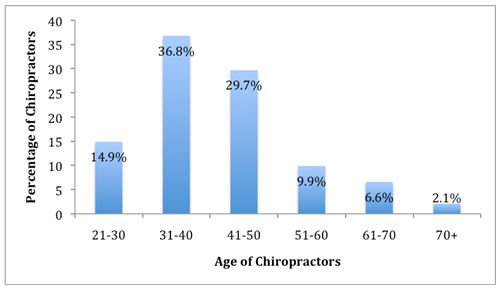
Gender
There is a slight increase in female chiropractors. The profession continues to attract more men than women. According to the survey of 2007 (figure 6) there was a slight increase in the number of female respondents — 19.6 percent,compared to 15.6 percent in 2006.
Male: 80.4%
Female: 19.6%
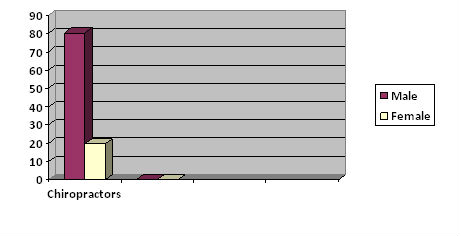
Level of activity
When asked to self-describe their level of activity in chiropractic practice, 85% of chiropractors stated that they were in full-time practice (Table 2). The average chiropractor in full-time practice in Canada during 1995-1996 reported working 49.1 weeks in a typical year, 4.9 days in a typical week, 41.3 hours in a typical day and 8.4 hours in a typical day.
| Level of Activity | Percentage of Chiropractors (%) |
| Full time | 85.0 |
| Part time | 8.7 |
| Retired | 1.7 |
| Semi-retired | 2.5 |
| Temporarily not in practice | 0.9 |
| Unemployed | 0.1 |
| In chiropractic field but primarily not in practice | 0.9 |
| Not in chiropractic field | 0.3 |
Patient visits in a typical week
Data here (Figure 7) shows the number of patient visits per week against the number of years in practice. The highest number of patient visits in a typical week (n=105) was found in the group that had been practicing for ten years and over.
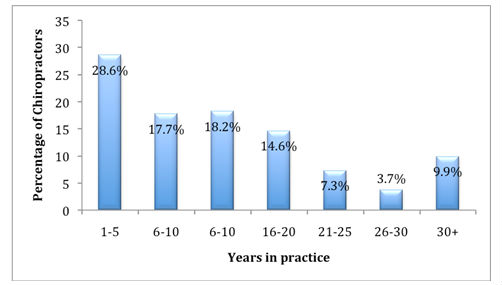
Years in practice
More than a quarter (28.6%) of all chiropractors had been in practice five years or less (Figure 8), and the mean number of years in practice was 13.7 years.

European Region – Finland
Based on a demographic survey of Chiropractors in Finland which was conducted in 2005.[54] Fifty members of the Finnish Chiropractic Union were involved in this study.
Demographic characteristics of Chiropractors in Finland
Age
The Finnish Chiropractic profession is relatively young and small, compared to other national chiropractic associations in Europe. According to the present survey, the members of the Finnish Chiropractic Union consisted of mainly men in their 30’s and 40’s (80%), who, in the majority of cases, graduated from university based or university affiliated chiropractic institutions. The age profile is shown in Figure 9.
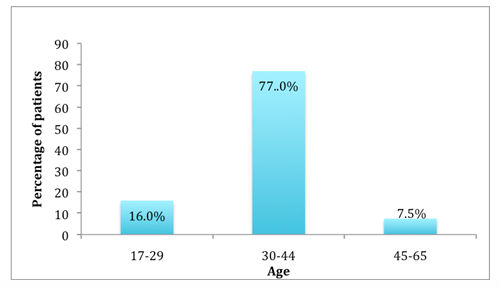
Gender
The gender ratio of Chiropractors in Finland shows that Male practitioners are much more common. The ratio is shown below:
Male: 80%
Female: 20%
Note: Additional information on other parts of Europe acquired from the administrative offices of corresponding associations in Sweden, Norway and Denmark reveals a different gender distribution, with 70%, 71% and 51%, respectively of men in the three countries. The proportion of male practitioners was lower (63%) also in a recent study of German chiropractors (response rate 72%).[55]
Scope of Practice
Solo practice was their main practice pattern. The vast majority described their scope of practice to be based on a musculoskeletal approach, using the Diversified Technique, performing Soft Tissue Therapy and about two-thirds also used an Activator Instrument (mechanical adjusting instrument). Please refer to Figure 10.
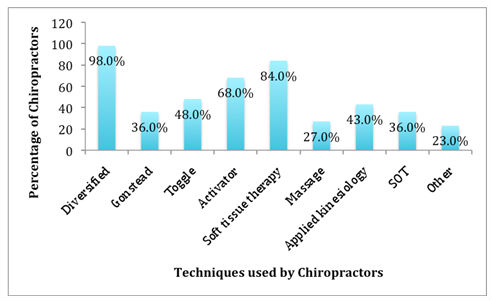
Various adjunctive therapies were used but none of these was used by all or even by the majority. This is documented in Figure 11. Ice was most commonly reported, by 46% whereas the use of ultrasound was very rare.
The use of adjunctive therapies showed a less distinct pattern, perhaps because chiropractors determined that different patients require different approaches. It was also interesting that about one-third of the respondents had some sort of rehabilitation equipment in their clinic, indicating that they also have the facility to assist patients with general or specific training following the acute treatment stage.
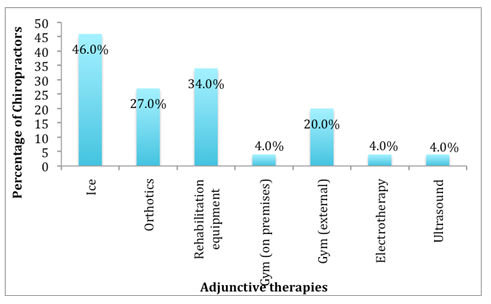
Time spent with patients
At the initial consultation, 80% of respondents spent 30–45 minutes with their patients, 75% spent 20–30 minutes with new old patients and on subsequent visits 80% of respondents spent 15–30 minutes. At one extreme, one respondent reported spending one minute only on subsequent visits. The number of patients seen was considered to be “about right” by 55%, and 9% reported they were seeing more patients than they would like to.
African Region – South Africa
Apart from South Africa, the Chiropractic profession is not wide-spread in Africa. Hence little data is available on the mainstream or normal practices of Chiropractic in different countries. The pattern of usage and utilisation of chiropractic is likely to reflect:
- The underlying philosophy or outlook of the practitioner and the institute from which he graduated and or any additional further study he or she has undertaken.
- Context adaptations to suit the accepted cultural norms relevant to either religion, social expectations of the role and behaviour of a “doctor”
- Adaptation to fit within the local laws relevant to the practice of medicine
Of interest is Myburgh and Mouton’s study of Chiropractors in South Africa [56] which highlights some of the challenges faced by Chiropractors in establishing the profession in the healthcare system in new markets. They interviewed Chiropractors and patients to compare their viewpoints. Results suggested “The patients interviewed responded that the strengths of the chiropractic profession lie in its social desirability and its health care utility”
Practitioners tended to “distinguish between 2 main views of the chiropractic identity-the “technician” and “physician.” They also felt that there was a “lack of conceptual identity of chiropractic; the absence of a coherent, marketable model of chiropractic practice; and poor interprofessional relationships with mainstream health care stakeholders.”
Demographic studies of the patients that visit chiropractors
The Average Chiropractic Patient Today
Recent studies report that the today’s population of chiropractic patients is approximately 60% female and 40% male, averaging 45 years of age; children were less than 4% of all visits. The four health concerns most frequently seen by the chiropractor, in order of occurrence are: back, neck, headache and shoulder pain. Of these chiropractic patients, roughly 80% were seen for a problem previously treated by that same chiropractor, i.e. chronic or recurrent condition. Care for the low back, head and neck pain accounted for about three out of four of these visits.
These studies show that the focus of most Chiropractic practices is not, pediatrics, sports medicine nor the elderly, but the treatment of recurring spinal pain in the middle age population. Furthermore, a correction in the metabolic function of these patients has tremendous ramifications in their health for decades to come. We need to start putting greater focus on understanding and treating these patients.
As we have seen our modern diet, lifestyle and environmental exposures are setting our patients up for the development of chronic metabolic dysfunction, problems such as: oxidative stress, systemic inflammation, insulin resistance, dyslipidemia and hyperhomocysteinemia, which all lead to the degenerative diseases of today. It is vital for the chiropractor of today to realize that one of the first signs of this metabolic dysfunction in your patients is recurring myofascial pain and fatigue.[57]
United States of America
The report is based on The Job Analysis Chiropractic 2005 conducted in the year 2003.[4] The Job Analysis report summarizes the practice of chiropractic in the United States with responses obtained from more than 2,500 full-time chiropractors from all 50 states and the District of Columbia. Survey respondents reported information on their daily tasks and professional responsibilities, as well as the conditions they see in their offices.
Demographic characteristics of patients in the USA
Age
Data from the current survey indicates that the percentage of patients under 17 years of age has increased 8.5% since the 1991 survey. Within the current survey, the highest percentage of patients is the 31- to 50-year-old range (29.8%), followed by 51- to 64-year-olds (21.0%), 18- to 30-year-olds (17.3%) and those 65 or older (13.7%) (Figure 12)
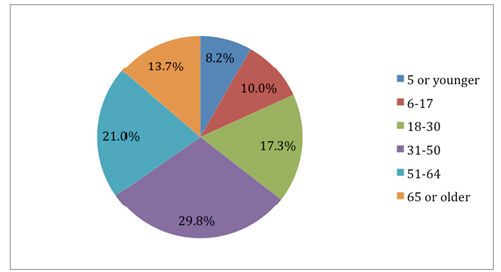
Gender
Male – 40%
Female – 60%
There has been essentially no change in this distribution since the 1991 NCBE Survey of Chiropractic Practice.
Ethnic background and Occupation
Chiropractors treat persons from all races and occupations. While the current survey did not ask about patient occupation, the previous two surveys (1991 and 1998) revealed that no single occupational group predominates. Caucasians represent the majority ethnic group of patients (56.7%). However, compared to the 1998 data, the percentage of Caucasian patients has declined 3.7%, and the percentage of each of the other ethnicities has increased (Figure 13).
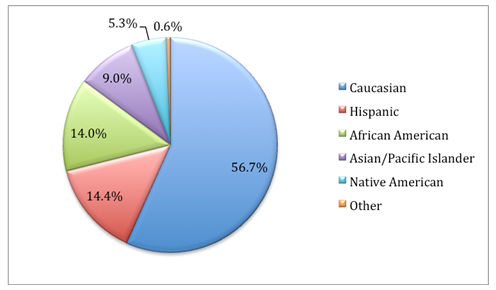
Type of problems or reasons for visiting a Chiropractor in the USA
A typical patient enters a chiropractor’s office complaining of some specific pain or problem (Figure 14).This complaint is frequently attributed to an injury or other stressor. For example, a work-related lifting injury, a kidney infection, and/or obesity might be related to, or may be the cause of, a patient’s low-back pain. The practitioner – based on a proper case history, physical examination, laboratory results, and other data – reaches a diagnostic conclusion that may or may not include vertebral subluxation.
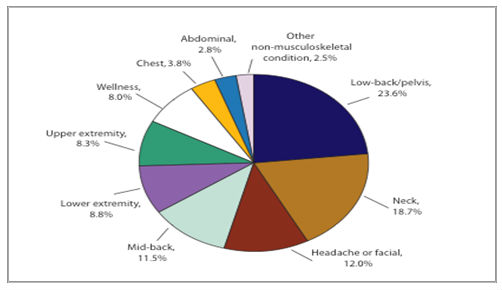
Canada
Based on the survey “The Chiropractic Patient: A Social Profile” by I.D Coulter which was conducted in 1977.[58] A total sample of 658 patients were interviewed and analysed. The data was collected on six demographic/social characteristics of the Canadian chiropractic patients. However, only four of them are shown here which are age, gender, marital status and socio-economic group within the society. In each case, comparisons are made to the general population.
It is worth noting that the results from Canada are similar to those obtained recently on a much larger although non-random sample in New Zealand. Such results seem to indicate a need for re-evaluation by sociologists of the conclusion that chiropractic patients come primarily from the lower socio-economic groups in society. They may also suggest that other major assumptions concerning chiropractors and their patients should be closely re-examined in light of empirical data.
Demographic characteristics of patients in Canada
Age
The categories used in this study differ from the ones adopted for the Canadian census, therefore the data on age distribution are more difficult to compare with the Canadian population.
However, a rough equivalence can be established as shown in Table 3. The table clearly shows that the categories under 19 years of age group are very under-represented in the patient population suggesting that chiropractic is not used as a health care alternative for this group. Also, the data clearly show that most of the patients fall within the working life span of most people (approximately 18 to 64 years of age). This would explain the predominance of married patients. Lastly, even though the elderly are also overrepresented in the patient sample it is not by a large amount.
| Patient Ages | Percentage(%) of Canadian chiropractic patients(1977) | Age in Years | Percentage(%) of Canadian population (1976) |
| Less than 3 (infants) | 0.2 | 0 – 4 | 7.5 |
| 3 – 12 (children) | 0.9 | 5 – 14 | 18.1 |
| 13 – 17 (teenagers) | 2.3 | 15 – 19 | 10.3 |
| Total less than 17 | 3.4 | Total less than 19 | 35.9 |
| 18 – 34 (young adults) | 25.5 | 20 – 34 | 25.1 |
| 35 – 49 (adults) | 29.5 | 35 – 49 | 16.7 |
| 50 – 64 (mature adults) | 27.5 | 50 – 64 | 13.6 |
| Total 18 – 64 | 82.5 | Total 20 – 64 | 55.4 |
| 65 and over (elderly) | 14.1 | 65 over | 8.7 |
Gender
Females outnumbered males for the first time in the Canadian census of 1976, with a ratio of 46 per cent male, 55 per cent female one hundred females. to every ninety-nine males. On the basis of one hundred females to every ninty-nine males, the patient sample contained more females than could be predicted but the difference was not particularly large.
Marital status
The Table 4 shows the marital status of patients along with the comparative figures of the Canadian population, and it clearly demonstrates that married people are considerably over-represented in the patient sample. However, the reason for this had been previously explained in the discussion of Table 3 by examining the age distribution of the patients.
| Status | Percentage of Chiropractic patients | Percentage of Canadian population(1976) |
| Married | 72.5 | 47.7 |
| Single | 15.3 | 46.4 |
Socio-economics
The data shown in Table 5 suggest that the distribution of occupations within the patients is not significantly different from the Canadian population, also that the proportion of high status occupations reported by the patients is close to the proportion reported within the general population, and lastly, that the chiropractic patients are in fact a cross-section of the population with regard to occupational status.
| Socio-economic & occupational categories | Percentage (%) |
| Professional | 9.8 |
| Proprietors, managers, and official of large companies | 1.8 |
| Semi-professional, technichians | 7.1 |
| Proprietors, managers and official supervisors of small companies, middle manegement | 11.4 |
| Clerical and sales | 20.3 |
| Skilled | 15.1 |
| Semi-skilled | 13.1 |
| Unskilled | 13.1 |
| Farmers/ Farm labourers | 8.2 |
| Level | Percentage (%) |
| Elementary graduate | 22.0 |
| Secondary graduate | 53.8 |
| College graduate | 9.1 |
| University | 11.9 |
Latin American region – Mexico
Data here is based on a demographic and epidemiological study of a Mexican chiropractic college public clinic.[59] Five hundred patient files from the UNEVE public clinic from May 2005 to May 2007 were selected from an approximate total number of 3,700.
Demographic characteristics of patients in Mexico
Age
Most of the patients were between the ages of 40 and 59 years. The age profile of the patients is presented in Figure 15.
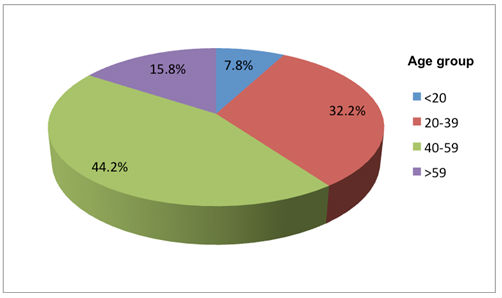
Gender
The sample comprised of 306 in which (61.2%) were female and (38.8%) were male.
Marital status
of the patients were married or in Civil Union arrangements. Only 28.8% were single. (Figure 16)
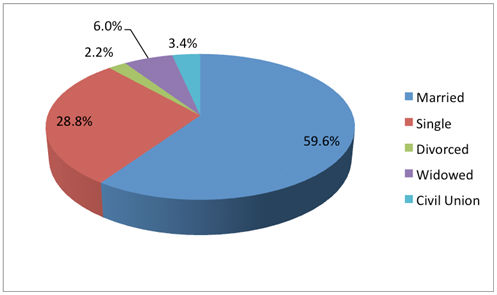
Socio-economic status
The largest group of Chiropractic patients in Mexico is composed of Blue collar or manual workers. They compromise almost one quarter of the patients.
Socioeconomic status data is documented in Figure 17.
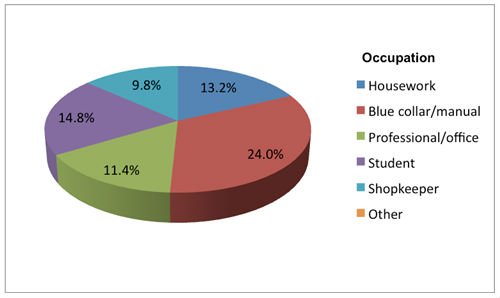
Type of problems or reasons for visiting a Chiropractor in Mexico
The most frequent complaints were lumbar pain (29.2%) and extremity pain (28.0) (Figure 18). Lumbar (29.2%) and extremities (28.0%) were the most prevalent primary complaints. A secondary and tertiary complaint was included if the patient reported more than one area of complaint. Secondary complaints were lumbar (27.4%) and extremities (17.1%). Sacrum and coccyx (21.1%), and extremities (25.0%) were tertiary complaints. In total, extremity complaints were recorded in 207 of the files (41.4%), with 101 (48.8%) of these listed as knee complaints.
This is nearly 2–4 times higher than field studies performed in the United States and Europe, and almost twice that of Australian studies. The percentage of extremity complaints is even higher when the secondary and tertiary complaints are included (41.4%). This would seem to coincide with the high percentage of causes due to trauma (47.0%). All age groups reported more traumas than any other cause in their respective groups.
It can be said that this population suffers from chronic complaints. By far, the majority of patients had complaints of greater than three months duration, with a high percentage of these greater than one year. Other studies have recorded similar chronic conditions, but this population averaged over four years with their complaints. This may suggest that either patients have chosen to live or have had to live with their conditions or had sought other care without adequate results before seeking chiropractic care. It is also possible, due to the paucity of chiropractic clinics throughout México that chiropractic care has just not been an available option until recently.
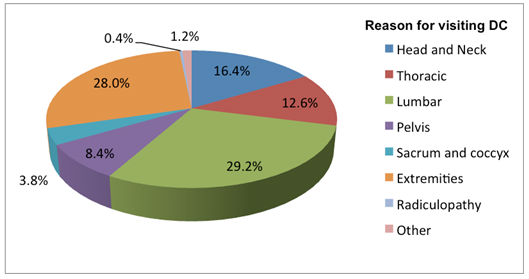
European region – Denmark
Based on a study of chiropractic patients in Denmark in 1999.[60] All chiropractic clinics in Denmark participated in the study.
Demographic characteristics of patients in Denmark
Age
Mean age: 42 years
Gender
Male: 40%
Female: 60%
The data suggests, for Denmark that females account for more visits to the chiropractor than men.
Type of problems or reasons for visiting a Chiropractor in Denmark
Most Danish chiropractic patients complain of pain related to the low back (50%) or neck (15%) of between 1 and 6 months’ duration. The majority of patients had complaints in the sub-acute or chronic category. Patients with sciatica had significantly higher pain scores and limitation in activities of daily living (ADL) than any other group, whereas patients with neck pain tended to score lower. Patients in the sub-acute category had the highest pain scores and limitation in ADL.
For complaints lasting more than 6 months, limitation in ADL remained constant at a low level. Twenty-three percent of all patients were referred to the chiropractor, most frequently by a general medical practitioner. More than half of all patients had previously been treated for the same or similar problems, most frequently by a chiropractor. Fifty-one percent had also received chiropractic care for other types of problems.
This study confirms that chiropractic is fairly well integrated into the Danish primary health care system.
African region – South Africa
Date here is based on a demographic and descriptive survey of chiropractic patients at the chiropractic clinic at Kimberly Public Hospital Complex conducted in 2009.[61] A sample of 157 patients were given a questionnaire regarding chiropractic practice in the hospital.
Demographic characteristics of patients in South Africa
Age
From the data recorded from the 157 patients sample, the mean age of patients was 47.5 years with a range from 3 to 87 years.
Gender
The majority of the patients were female (70%), comprised of coloured and black patients (85%), where the greater part had a primary education level.
Ethnicity
Of the sample of patients documented it was shown that 53.2% of the sample were Black, 31.4% Coloured, 14.1% White and only 1.3% Indian (Figure 19).
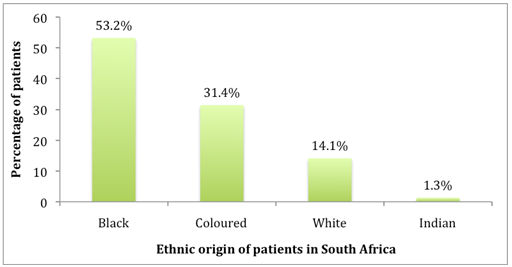
Schooling and Education
A greater part of the sample group had completed primary school education (51.6%), with a smaller proportion having completed high school education (23.9%). There were 9% who had some primary schooling and 7.7% with no education. Of this sample group only 7.7% had received a tertiary education. Refer to Figure 20.
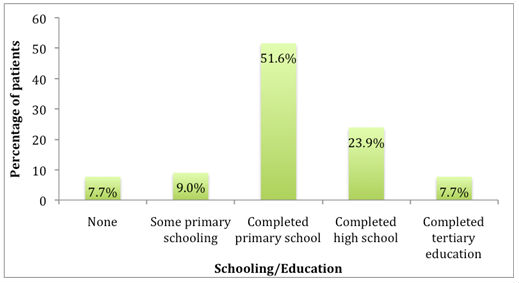
Employment profile
It was documented that 42.9% of the sample group was employed, 30.5% were unemployed and 22.7% were pensioners, whereas only 3.9% of students sought chiropractic care. This is demonstrated in Figure 21.
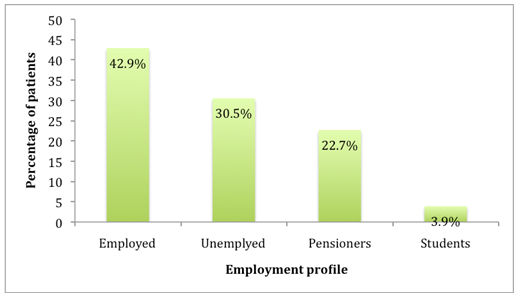
Occupation
The question was not applicable to a large proportion of the sample group as they were either unemployed, pensioners or scholars (58.3%). Of those that were employed, 15.4% were manual labourers, 14.7% did a combination of manual and non manual work, and 11.5% were non manual workers. Refer to Figure 22.
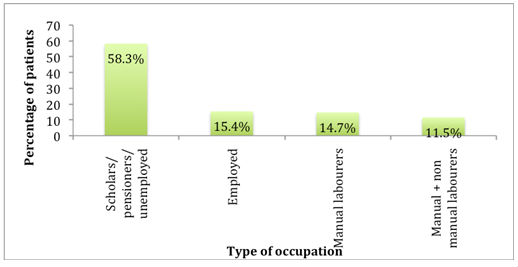
Type of problems or reasons for visiting a Chiropractor in South Africa
The most common specific location of complaint was lumbar pain (35%) followed by sacroiliac pain (31.2%), shoulder pain (26.8%), leg pain (, 22.4%), neck pain (18.5%), hip pain (10.9%), knee pain (10.8%), thoracic pain (7.0%), elbow pain (6.4%), headache associated with neck pain (5.1%). See Figure 23.
In terms of the anatomical location of complaint the specific areas of complaint were categorized for a concise overview into five main areas from the highest to the lowest number of reports, namely spinal complaints (91.7%), lower extremity complaints (55.4%), upper extremity complaints (43.3%) and headache (13.3%). An “other category” was included for those complaints that reflected anatomical locations of pain that did not fall into any of the above-mentioned categories. These included chest pain, iliac crest pain, general body pains, insomnia, facial pain, oedema (6.3%).
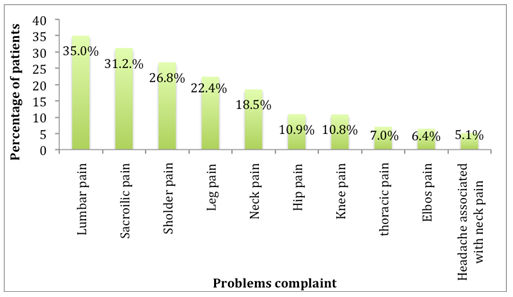
Australia
Sample data from Australia is based on the profile of middle-aged women who consulted a chiropractor or osteopath.[62] The findings shown here from a survey of 11,143 Australian Women show that an estimated 16% of middle-aged women consult with a chiropractor or osteopath (after adjustment for the over sampling of rural women). Area of residence, education, and employment status were all statistically significantly associated with chiropractic and osteopath use.
Specifically, women who live in non urban areas were more likely to consult a chiropractor or osteopath, compared with women who live in urban areas. Women are significantly more likely to consult with a chiropractor/osteopath if they have had a major personal injury in the previous year, and women who use chiropractic/osteopathy are also high users of ‘conventional’ health services.
References
- Keating JC, Jr. Shades of straight: diversity among the purists. J Manipulative Physiol Ther 1992;15 (3):203-209.
- Lawrence DJ, Meeker WC. Chiropractic and CAM utilization: a descriptive review. Chiropr Osteopat [serial online] 2007 [cited 2010 Feb]; 15(2). Available from: URL:http://www.chiroandosteo.com/content/15/1/2
- Myburgh C, Mouton J. Developmental issues in chiropractic: a South African practitioner and patient perspective. J Manipulative Physiol Ther 2007;30 (3):206-214.
- National Board of Chiropractic Examiners. Job analysis of chiropractic 2005 [serial online] 2005 Jan [cited 2010 Feb]; 121-138. Available from: URL: http://www.nbce.org/publication/job-analysis.html
- American Chiropractic Association. Chiropractic techniques [Online]. 2003 Aug [cited 2010 Feb]; Available from: URL:http://www.acatoday.org/pdf/PDR/ChiropracticTechniques.pdf
- The Chiropractors Directory. Chiropractic applications [Online]. 2010 [cited 2010 Feb]; Available from: URL:http://chiropractors.healthprofs.com/cam/content/chiropractic_treatments.html
- National University of Health Sciences. Flexion-distraction technique [Online]. 2010 [cited 2010 Feb]; Available from: URL:http://www.nuhs.edu/show.asp?durki=539
- Rosen MG, Blum CL. Sacro occipital technique in Today’s Chiropractic [Online]. 2000 Sep/Oct [cited 2010 Feb]; Available from: URL:http://www.todayschiropractic.com/issues/archives/
- The International College of Applied Kinesiology- U.S.A [Online]. 2000 Sep/Oct [cited 2010 Feb]; Available from: URL:http://www.icakusa.com/
- Laws SK. Nimmo-receptor tonus technique. The American Chiropractor [Online] 2005 Oct 30 [cited 2010 Feb]; 25(02). Available from:URL:http://www.theamericanchiropractor.com/print.asp?articleid=481&category=3
- Anrig C. Logan basic technique and pregnancy care. Dynamic Chiropractic [Online] 2007 Jan 15 [cited 2010 Feb]; 28(4). Available from: URL: http://www.dynamicchiropractic.com/mpacms/dc/article.php?id=52019
- The Green Books; compiled by Rob Sinnott. Toggle recoil adjustment: chapter 7 [Online] 2005 Oct 30 [cited 2010 Feb]; 117-118. Available from: URL:http://www.uppercervicalspine.com/tech8.htm
- Lange Chiropractic. Techniques: motion analysis (Palpation) [Online]. 2010 [cited 2010 Feb]; Available from: URL:http://www.langechiropractic.com/index.cfm?go=techniques&TechniqueID=7
- Barnes, John F. Myofascial release: the search for excellence. 10th ed. Rehabilitation Services Inc; 1990.
- Peace Chiropractic Clinic. Intersegmental traction [Online]. 2010 [cited 2010 Feb]; Available from: URL:http://www.peacechiro.com/treat_traction.htm
- Joint Mobilization. Technique utilized in chiropractic [Online]. 2010 [cited 2010 Feb]; Available from: URL: http://www.educ.uidaho.edu/jwilliams/HS%20467/Joint%20Mobilization.ppt.
- Tedd Koren Seminars. Koren specific technique [Online]. 2010 [cited 2010 Feb]; Available from: URL:http://www.teddkorenseminars.com/kst.asp
- The Pettibon System™. The pettibon system [Online]. 2010 [cited 2010 Feb]; Available from: URL: http://www.pettibonsystem.com/
- Become Healthy Now.Com. Chiropractic technique- an explanation [Online]. 2010 [cited 2010 Feb]; Available from: URL:http://www.becomehealthynow.com/article/chirotechniques/663/
- International Chiropractic Pediatric Association. Webster technique defined [Online]. 2010 [cited 2010 Feb]; Available from: URL:http://icpa4kids.com/about/webster_technique.htm
- Toftness. WD Online.biz Business Catalog [Online]. 2010 [cited 2010 Feb]; Available from: URL: http://wdonline.biz/company/262035/
- Chiro Community.com. Chiropractic terms [Online]. 2010 [cited 2010 Feb]; Available from: URL:http://www.chirocommunity.com/terms.htm
- Blair Chiropractic Society. What is blair upper cervical care? [Online]. 2010 [cited 2010 Feb]; Available from: URL:http://www.blairchiropractic.com/
- Julet Hutchens. Glossary of chiropractic terms [Online]. 2010 [cited 2010 Feb]; Available from: URL:http://drjhutchens.com/glossary.html
- The Council of Chiropractic Practice [Online]. 2010 [cited 2010 Feb]; Available from: URL:http://www.ccp-guidelines.org/
- A Bigger Toolbox. Adjunctive therapies expand the chiropractic repetoire: J Am Chiropr Assoc. 2003 July;40(7):10-12.
- Federation of Straight Chiropractors and Organizations Online]. 2010 [cited 2010 Feb]; Available from: URL:http://www.straightchiropractic.com/
- Hall Chiropractic. Services: Ultrasound [Online]. 2010 [cited 2010 Feb]; Available from: URL:http://www.hall-chiropractic.com/services.php?p=ultrasound
- Chiropractic Works in Anderson, Indiana. Ultrasound [Online]. 2010 [cited 2010 Feb]; Available from: URL:http://www.drkeithberger.com/chiropracticservices/physiotherapy/therapeutic-ultrasound/
- Chiroeco.com. Chiropractic news: understanding ultrasound [Online]. 2010 [cited 2010 Feb]; Available from: URL:http://www.chiroeco.com/chiropractic/news/7296/47/understanding-ultrasound/
- MedicineNet.com. Definition of acupuncture [Online]. 2010 [cited 2010 Feb]; Available from: URL:http://www.medterms.com/script/main/art.asp?articlekey=2132
- Ing Chiropractic. Acupuncture [Online]. 2010 [cited 2010 Feb]; Available from: URL:http://www.chinatownchiro.net/2009/acupuncture/
- Acupuncture Treatment.com. The benefits of Acupuncture [Online]. 2010 [cited 2010 Feb]; Available from: URL: http://www.acupuncture-treatment.com/benefits.html
- Tega Cay Chiropractic & Sports Injury Clinic. Custom foot orthotics [Online]. 2010 [cited 2010 Feb]; Available from: URL:http://www.tegacaychiropractic.com/services/Custom_Foot_Orthotics.htm
- Foot logics. Research about orthotics in relation to heel, knee and back pain [Online]. 2010 [cited 2010 Feb]; Available from: URL:http://painfreewalking.co.uk/research-orthotics.html
- Vasyli Medical. Research: the short term treatment of plantar fasciitis using sample “off the shelf” foot orthoses [Online]. 2010 [cited 2010 Feb]; Available from: URL:http://www.vasylimedical.com/resources/research_plantar_fasciitis.html
- Millwood chiropractic & Wellness Centre. Therapies offered: interferential current (IFC) [Online]. 2010 [cited 2010 Feb]; Available from: URL:http://www.millwoodchiro.com/chiropractic/chiropractic_treatment_types.html
- South Jersey Chiropractic. Electro-muscle stimulation (EMS) [Online]. 2010 [cited 2010 Feb]; Available from: URL:http://www.southjerseychiro.com/services.html#ems
- Performance Chiropractic.EMS electrical muscle stimulation [Online]. 2010 [cited 2010 Feb]; Available from: URL:http://www.performancechiro.org/ems.html
- Erin McLaughlin. Electrical Muscle Stimulation [Online]. 2010 [cited 2010 Feb]; Available from: URL: http://erin-mclaughlin.suite101.com/electric-muscle-stimulation-therapy-a180833
- Robinson AJ, Snyder-Mackler L. Clinical application of electrotherapeutic modalities. Phys Ther. 1988 Aug;68(8):1235–1238.
- WebMD. Transcutaneous electrical nerve stimulation (TENS) – topic overview.com [Online]. 2010 [cited 2010 Feb]; Available from: URL:http://www.webmd.com/pain-management/tc/transcutaneous-electrical-nerve-stimulation-tens-topic-overview
- Spineunivrse. Transcutaneous electrical nerve stimulation (TENS) [Online]. 2010 [cited 2010 Feb]; Available from: URL:http://www.spineuniverse.com/displayarticle.php/article1694.html
- Wikipedia.Transcutaneous electrical nerve stimulation [Online]. 2010 [cited 2010 Feb]; Available from: URL:http://en.wikipedia.org/wiki/Transcutaneous_electrical_nerve_stimulation
- Neurosurgeon announces findings in posture pump research. J Chiro [serial online] 2006 Sept [cited 2010 Feb]; Available from: URL:http://www.worldchiropracticalliance.org/tcj/2006/sep/g.htm
- Posturepump.com. Posture pump-superior for neck pain [Online]. 2008 Feb [cited 2010 Feb]; Available from: URL:http://www.posturepump.com/images/PremliminaryFindings.pdf
- What others are saying about Posture Pump® Disc Hydrator® [online]. 2010 [cited 2010 Feb]; Available from: URL:http://www.posturepump.com/testimonials.aspx
- WebMd. Magnetic resonance imaging (MRI) [Online]. 2010 [cited 2010 Feb]; Available from: URL:http://www.webmd.com/a-to-z-guides/magnetic-resonance-imaging-mri
- Wikipedia. Magnetic resonance imaging [Online]. 2010 [cited 2010 Feb]; Available from: URL:http://en.wikipedia.org/wiki/Magnetic_resonance_imaging
- Wikipedia. X-ray [Online]. 2010 [cited 2010 Feb]; Available from: URL:http://en.wikipedia.org/wiki/X-ray#Medical_uses
- Chiropractic and CAM Utilization: A Descriptive Review [Online]. 2010 [cited 2010 Feb]; Available from: URL: http://www.chiroandosteo.com/content/15/1/2
- Pollentiera A, Langworthy JM. The scope of chiropractic practice: a survey of chiropractors in the UK: Clinical Chiropractic; 2007 Sept.p.147-155. (vol 10, issue 3).
- Opportunities in chiropractic: choosing a practice location. Canadian Chiropractic Association; 1998.p.7-11.
- Malmqvist S, Leboeuf-Yde C. Chiropractors in Finland – a demographic survey. J Foot Ankle Res [serial online] 2008 Aug [cited 2010 Feb]; 16(9). Available from: URL:http://www.chiroandosteo.com/content/16/1/9
- Schwarz I, Hondras MA. A survey of chiropractors practicing in Germany: practice characteristics, professional reading habits, and attitudes and perceptions toward research. Chiropr Osteopat [serial online] 2007 May [cited 2010 Feb]; 15(6). Available from: URL:http://www.chiroandosteo.com/content/15/1/6
- Myburgh C, Mouton J. Developmental issues in chiropractic: A South African practitioner and patient perspective. J Manipulative Physiol Ther [serial online] 2007 Mar [cited 2010 Feb]; 3:206-214. Available from: URL: http://www.jmptonline.org/article/S0161-47
- (07)00049-8/abstract
- Fors G. Wellness strategies for today’s chiropractic patient [Online]. 2010 [cited 2010 Feb]; Available from: URL:http://www.fettermanevents.com/ChronicPainarticle.doc.
- Coulter ID. The chiropractic patient: a social profile. J Can Chiro Assoc [serial online] 1985 Mar [cited 2010 Feb]; 29(1). Available from: URL:http://www.ncbi.nlm.nih.gov/pmc/articles/PMC2484897/
- Martinez DA, Rupert RL, Ndetan HT. A demographic and epidemiological study of a Mexican chiropractic college public clinic. Chiropr Osteopat [serial online] 2009 Mar [cited 2010 Feb]; 17(4). Available from: URL:http://www.chiroandosteo.com/content/17/1/4
- Hartvigsen J, Sorensen LP, Graesborg K, Grunnet-Nilsson N. Chiropractic patients in Denmark: a short description of basic characteristics. J Manipulative Physiol Ther [serial online] 2002 Mar [cited 2010 Feb]; 25(3):162-7. Available from: URL:http://www.ncbi.nlm.nih.gov/pubmed/11986577
- Higgs M. A demographic and descriptive survey of chiropractic patients at the chiropractic clinic at Kimberly hospital complex. [Online]. 2009 [cited 2010 Feb]. Available from: URL:http://ir.dut.ac.za/handle/10321/452
- Sibbritt D, Adams J, Young AF. A profile of middle-aged women who consult a chiropractor or osteopath: findings from a survey of 11,143 Australian women. J Manipulative Physiol Ther [serial online] 2006 June [cited 2010 Feb]; 29(5):349-353. Available from: URL:http://www.jmptonline.org/article/S0161-4754(06)00092-3/abstract



